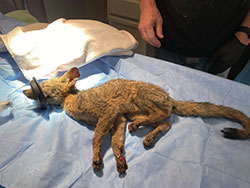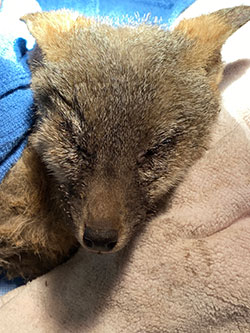Fox finishing out rehabilitation and being prepped for release at Sierra Wildlife Rescue. Photo © Jackie Young

Injured fox at Sierra Wildlife Rescue being prepped for initial debriding and cleaning of injured paws. Photo © Sierra Wildlife Rescue

Injured fox shortly after being removed from under a porch in Pollock Pines. Photo © Sierra Wildlife Rescue
Each year, Californians filing their individual state income taxes can choose to donate money from their refunds or payments to the California Department of Fish and Wildlife’s (CDFW) Native Wildlife Rehabilitation Fund, line 403 on state tax form 540. Money from this Fund is then distributed through a CDFW competitive grants program that helps California rehab facilities support activities such as veterinarian treatment, animal care, facility maintenance and conservation education.
Sierra Wildlife Rescue (SWR) rehab facility in El Dorado County is a recipient of this funding, and recently helped a young, badly burned and injured California gray fox (kit) recover and be released back into the wild.
The kit was discovered hiding under the porch of a home in Pollack Pines on Sept. 6, 2021, after its residents returned from being evacuated from the Caldor Fire. The kit was estimated to be three to four months old, emaciated, burned and had extreme damage to its paws.
“It took three days for our team to get the fox out from under the porch,” said Debbie Buckles, board president of SWR. “Once we got it out, we could see that not only was she singed, but she lost ear tips, and her feet were basically burned to the bone.”
SWR is usually called in on El Dorado County cases where injured, orphaned or sick wildlife are concerned. Their mission is to rehabilitate wildlife with minimal human/wildlife interaction in hopes to better the chances of a successful release back into the wild.
“We anesthetized her and debrided and cleaned the wounds,” said Dr. Marsha Birdsall, volunteer veterinarian with SWR. “Once she was bandaged up, we transferred her to one of our home rehab facilities. These are homes of our volunteer rehabbers that have larger properties with larger outdoor enclosures.”
At the home rehab facility, the fox was able to heal in an outdoor environment and be monitored by wildlife cameras set up around the property. This helps ensure that the animal will not imprint on people or begin to rely on human interaction while being monitored.
After nearly eight weeks, the fox’s injuries were getting better, but with some setbacks. Her burned and damaged skin and paws were healing, but she lost every paw pad, claw and several toes. SWR was concerned the lack of claws, paw pads and toes would make it difficult to return the kit to the wild.
“Our action plan in general is to return these animals to the wild,” said Buckles. “But we were concerned she wouldn’t be able to catch live prey or protect herself from larger animals.”
Thinking the fox would not be able to hunt or climb trees to avoid predators without her claws and toes, SWR reached out to their grant partner CDFW to see if the department knew of another facility that would take the kit in as an educational animal.
CDFW contacted Sonoma County Wildlife Rescue in Petaluma, and on Dec. 14, 2021, the kit was transferred to their facility where the team planned for it to live out its days at their outdoor facility. What the Sonoma County rehab team saw the kit doing while monitoring their property’s wildlife cameras, no one saw coming.
“The fox started showing signs that she could catch prey,” said Buckles. “She also found a way to climb. She would wrap her limbs around the tree, like a hug, and shimmy her way up.”
Sonoma County Wildlife Rescue began continuously conducting live prey testing with the fox, and it continuously would hunt and eat the prey. By mid-February, despite not having front or back claws, the fox was digging, climbing, hunting and grooming itself effectively.
“Now knowing the fox can hunt, climb, defend and groom itself we made the decision to bring her back from Sonoma County Wildlife Rescue and release her back into the wild in El Dorado County,” Buckles said.
The fox was released back into the wild in El Dorado County on March 2, 2022, after nearly six months of being rehabbed.
“We don’t usually name the animals in our care because they are not our pets, they’re wild animals,” said Buckles. “… but this fox overcame so much, and we were all so invested in her making it back to the wild that we now call her Phoenix, because there’s a story that says the Phoenix bird rises out of the ashes. That’s what this fox did, it rouse out of the Caldor Fire ashes.”
CDFW’s Wildlife Rehabilitation Program currently works with more than 80 permitted rehab facilities (PDF) like SWR and Sonoma County Wildlife Rescue across the state. For the 2022 grant cycle alone, CDFW has distributed $547,000 to these facilities for them to continue their work in their communities.
“These facilities along with their satellites and army of volunteers are the ones who put in the long, hard hours year after year to successfully rehab injured, orphaned or sick animals and birds of California,” said Heather Perry, CDFW’s Wildlife Rehabilitation Program Coordinator. “When tax-filers make the choice to contribute to the Native Wildlife Rehabilitation Tax Fund, their support allows for grant funding that SWR, Sonoma County Wildlife Rescue and many of our other permitted rehab facilities utilize to fund their work. The story of the Caldor Fire fox is just one example of what we can do when we all work together.”
For more information on the Native Wildlife Rehabilitation Fund, please visit wildlife.ca.gov/tax-donation.
*According to CalFire records, the Caldor Fire started on Aug. 14, 2021and was active for 67 days. The fire burned through nearly 222,000 acres in El Dorado, Amador and Alpine Counties and destroyed 1,003 structures.
Media contact:
Leticia Palamidessi, CDFW Education and Outreach, (916) 708-8517